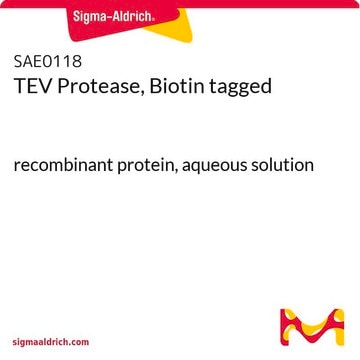推荐产品
生物源
human (human Rhinovirus Type 14)
重組細胞
expressed in E. coli
化驗
≥90%
形狀
aqueous solution
比活性
≥5000 U/mg
分子量
22 kDa
濃度
0.8-1.2 mg/mL
技術
protein purification: suitable
適合性
suitable for protein modification
應用
life science and biopharma
運輸包裝
dry ice
儲存溫度
−20°C
一般說明
HRV-3C protease from human rhinovirus type 14 is a protease that specifically cleaves within an eight-residue recognition sequence.This sequence is: Leu-Glu-Val-Leu-Phe-Gln-Gly-Pro.Proteolytic cleavage occurs between the Gln and Gly residues. The HRV-3C protease is useful for cleaving recombinant proteins that are expressed as fusion proteins with this sequence between the carrier domain and the protein of interest.
This biotinylated HRV-3C protease is intended for on-column cleavage of fusion proteins with an HRV-3C cleavage site. It specifically cleaves the protein of interest from a column-bound fusion protein, leaving the fusion domain or tag bound to the affinity column (e.g. Ni-NTA column) and eluting only the protein of interest. This method is advantageous over post-elution cleavage for several reasons:
After cleavage, the protease can be removed with any avidin-conjugated or streptavidin-conjugated beads. This product has been enzymatically biotinylated with no effect on its proteolytic activity. It has no additional protein purification tags. The product is supplied in aqueous buffer (0.8–1.2 mg/mL) with 20 mM Trizma®-HCl, pH 8.0, 200 mM NaCl, 1 mM TCEP, and 50% (v/v) glycerol.
This biotinylated HRV-3C protease is intended for on-column cleavage of fusion proteins with an HRV-3C cleavage site. It specifically cleaves the protein of interest from a column-bound fusion protein, leaving the fusion domain or tag bound to the affinity column (e.g. Ni-NTA column) and eluting only the protein of interest. This method is advantageous over post-elution cleavage for several reasons:
- It eliminates most impurities normally associated with purification on Ni-chelating columns.
- It allows gentler elution conditions, with added flexibility in the elution buffer composition. This can mitigate protein aggregation and inactivation.
After cleavage, the protease can be removed with any avidin-conjugated or streptavidin-conjugated beads. This product has been enzymatically biotinylated with no effect on its proteolytic activity. It has no additional protein purification tags. The product is supplied in aqueous buffer (0.8–1.2 mg/mL) with 20 mM Trizma®-HCl, pH 8.0, 200 mM NaCl, 1 mM TCEP, and 50% (v/v) glycerol.
準備報告
The product is supplied in aqueous buffer (0.8–1.2 mg/mL) containing 20 mM Trizma®-HCl, pH 8.0, 200 mM NaCl, 1 mM TCEP, and 50% (v/v) glycerol.
法律資訊
Trizma is a registered trademark of Merck KGaA, Darmstadt, Germany
儲存類別代碼
10 - Combustible liquids
水污染物質分類(WGK)
WGK 2
閃點(°F)
Not applicable
閃點(°C)
Not applicable
Dual inhibition of SARS-CoV-2 and human rhinovirus with protease inhibitors in clinical development.
Cheng Liu et al.
Antiviral research, 187, 105020-105020 (2021-01-31)
The 3-chymotrypsin-like cysteine protease (3CLpro) of severe acute respiratory syndrome coronavirus 2 (SARS-CoV-2) is considered a major target for the discovery of direct antiviral agents. We previously reported the evaluation of SARS-CoV-2 3CLpro inhibitors in a novel self-assembled monolayer desorption
Michael D Scholle et al.
SLAS discovery : advancing life sciences R & D, 26(8), 974-983 (2021-06-22)
Affinity selection mass spectrometry (ASMS) has emerged as a powerful high-throughput screening tool used in drug discovery to identify novel ligands against therapeutic targets. This report describes the first high-throughput screen using a novel self-assembled monolayer desorption ionization (SAMDI)-ASMS methodology
Margot A Cousin et al.
Nature genetics, 53(7), 1006-1021 (2021-07-03)
SPTBN1 encodes βII-spectrin, the ubiquitously expressed β-spectrin that forms micrometer-scale networks associated with plasma membranes. Mice deficient in neuronal βII-spectrin have defects in cortical organization, developmental delay and behavioral deficiencies. These phenotypes, while less severe, are observed in haploinsufficient animals
Alon Wellner et al.
Nature chemical biology, 17(10), 1057-1064 (2021-06-26)
The predominant approach for antibody generation remains animal immunization, which can yield exceptionally selective and potent antibody clones owing to the powerful evolutionary process of somatic hypermutation. However, animal immunization is inherently slow, not always accessible and poorly compatible with
Manzar Hossain et al.
Molecular cell, 81(9), 1951-1969 (2021-03-25)
The initiation of DNA replication involves cell cycle-dependent assembly and disassembly of protein complexes, including the origin recognition complex (ORC) and CDC6 AAA+ ATPases. We report that multiple short linear protein motifs (SLiMs) within intrinsically disordered regions (IDRs) in ORC1
商品
Proteases for biotinylated tag removal for protein purification workflows with related reagents and technical resources.
我们的科学家团队拥有各种研究领域经验,包括生命科学、材料科学、化学合成、色谱、分析及许多其他领域.
联系技术服务部门








